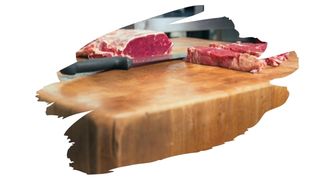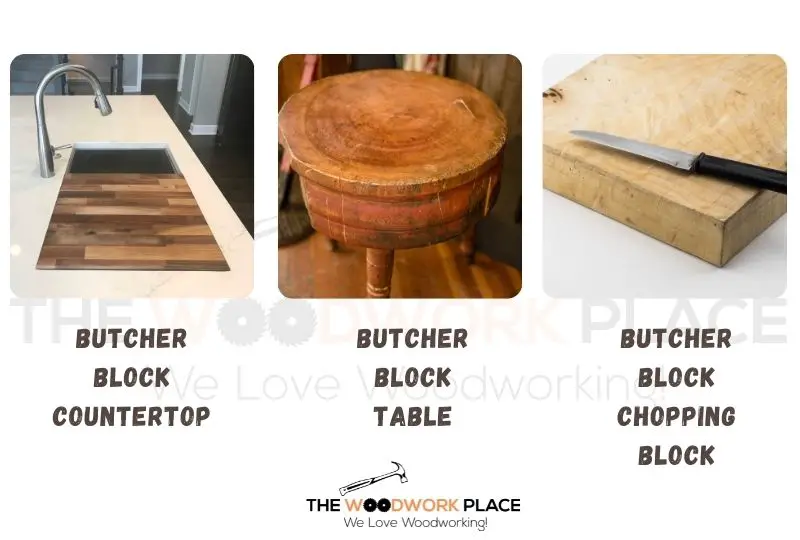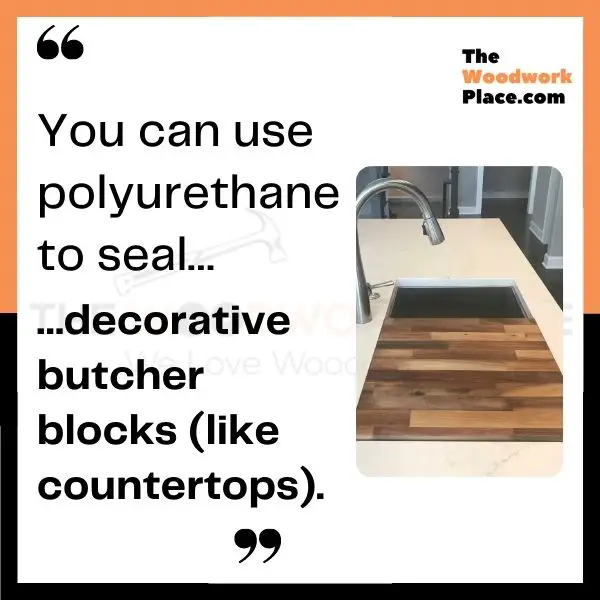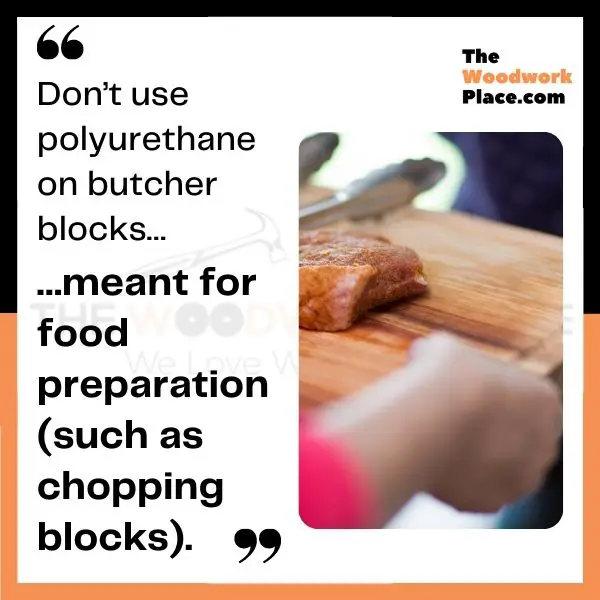Not all butcher blocks are used for food preparation. But, if your butcher block does (or will) see the ‘chop’ on the regular, then using a food safe wood finish is incredibly important.
Once polyurethane has dried and cured, it is safe enough to eat your dinner off. And that’s all well and good for a countertop.
But, a ‘food safe’ finish doesn’t take into account the risks involved with using polyurethane on a regularly used chopping block.
So, in this post you will find out why a food safe finish does not equal a food-grade finish. You will also discover why putting polyurethane on a butcher block can pose cross-contamination risks.
And we reveal what oil finish can be safely used to protect a timber chopping block...

This post may contain affiliate links to products that we receive a commission for (at no additional cost to you). Learn more here.
Can You Put A Polyurethane Finish On A Butcher Block?
First off, all butcher blocks are crafted out of hefty lumber.
Made from dense hardwood, such as Maple, these kitchen items can handle big chopping blows. They can also mask the cuts and small scratches that go along with meat prep.
Related Post: Cherry Vs Maple Cutting Boards (3 Essential Comparisons)
But, butcher blocks generally are crafted into one of three things; a countertop, a small table, or a chopping block.
Butcher blocks that are countertops or tables aren’t typically used as food prep surfaces (in and around the home). Instead, they tend to be more decorative than anything.
However, butcher blocks that come in the more traditional form of a portable chopping block, are widely used for food prep. And they can tend to look like thickly sliced cutting boards.

So, whether or not you can put polyurethane on a butcher block depends on what that butcher block will be used for.
If the butcher block is decorative, and won’t be used for food prep, then polyurethane will work fine as a finish.
Otherwise, if that block will be used for food preparation, then keep polyurethane away from it.
Related Post: Don’t Put Polyurethane Over Mineral Oil (Do This Instead)
So, Does That Make Polyurethane Perfectly Safe For Countertops?
Yes it does. On a butcher block countertop, polyurethane makes for an excellent durable sealer. It will wrap wood in a plastic-like coat that is very water-resistant and easy to clean.
And Should You Use A Food Grade Polyurethane For Butcher Block Countertops?
A food grade polyurethane? There’s no such thing.
When we say something is ‘food grade’, we are referring to the fact that it is safe for human consumption.
Polyurethane, (whether it be water-based or oil-based), contains toxins that should not be consumed whatsoever.
However, polyurethane in its cured form is in fact food safe. And what this means is that once polyurethane has dried and cured into a hard tough film, it’s no longer toxic.

Does That Mean Polyurethane Is Always Food Safe?
In short, a food safe polyurethane is one that has cured. And while it can take polyurethane up to 24 hours to feel dry to the touch, it takes much (much!) longer for it to cure.
You see, curing does not mean ‘dry’ (even though the two terms are used interchangeably). Instead, ‘curing’ describes a chemical reaction that polyurethane goes through.
This curing process happens in addition to the ‘drying’ evaporation process. And this curing process can take weeks to complete.
A water-based polyurethane can take up to 3 weeks to cure. While an oil-based polyurethane takes even longer, clocking in at over 30 days to wholly cure, (albeit longer in humid or cold weather).
Related Post: Polyurethane Not Drying? What You Can Do To Fix It
If Polyurethane Is Safe For A Countertop, Why Is It Not Safe For A Chopping Block?
Well, polyurethane itself isn’t really the problem. The problem lies in the way we use chopping blocks.
All of that chopping, cutting, and washing, means that polyurethane finish is going to be more of a hindrance than a help…
4 Reasons Why You Should NOT Use Polyurethane On Your Butcher Block
1). A Polyurethane Finish Can Be Damaged When You Cut Into Food
If you chop hard enough, you can easily cut through even a cured polyurethane finish.
And those finely sliced cuts will turn your water-resistant poly sealer into a sieve. Which means that raw meat liquids, and moisture, will soak into the wood underneath.
That moisture will cause that maple hardwood to dry out and crack. Or twist and warp.
But, even more worryingly, it can expose you to the greater risk of food poisoning, due to the cross-contamination of raw meat.
2). A Damaged Polyurethane Finish Is Not Easily Repaired
Fixing a damaged polyurethane finish is no mean feat.
The only way to properly fix a messed up poly finish is to sand down the damaged area, and then reapply a thin coat.
And even then, you will need to wait another 3-4 weeks for it to cure before using that butcher block.

3). A Polyurethane Finish Doesn’t Work Over Oily Wood
Just to clarify here, polyurethane can be applied over oiled wood. So, you can put poly over any Linseed oil, Tung oil, or almost any drying oil coat.
Related Post: Don’t Use Tung Oil On Your Cutting Board (Use This Instead)
But, the key word here is ‘drying’.
If a butcher block has been sealed with a drying oil finish (meaning that the oil finish has dried, cured, and hardened), then polyurethane will adhere to it. Of course, this is provided that drying oil finish has first completely cured.
However, if you’ve used a non-drying oil to finish your butcher block, then you’re going to run into adhesion problems.
Polyurethane won’t stick and stay on non-drying oil such as Mineral oil, (a wildly popular oil finish used on cutting boards and chopping blocks). If you try to apply that poly finish onto oily wood, it will peel off over time.
Related Post: Walnut Oil Vs Mineral Oil: Which One’s Better For Your Cutting Board?
4). Butcher Block Chopping Blocks Need Food Grade (Not Just Food Safe) Finishes
Tung oil, Linseed oil, Danish oil and Polyurethane. These are all food safe finishes.
However, chopping blocks ideally need a finish that is safer than even that. Chopping blocks need a food grade finish, not just a food safe one.
Which is why food-grade 100% pure mineral oil is the best finishing option for a chopping block.
This penetrating oil finish is non-drying, and enhances wood grain brilliantly. It doesn’t decay or go rancid, as it is made from petroleum distillate. It isn’t toxic either, as this petroleum-sourced product is highly refined and filtered.
Best of all, it is water-repellent, helping to protect wood by making its fibers less water absorbent.
Mineral oil finishes are much easier to apply and maintain than a polyurethane finish too. And you won’t need to wait long (after application) to begin using your butcher block.
You can begin using a chopping block within 24 hrs of an application of mineral oil.
To Wrap Up, Here Are The 3 Key Takeaways From This Post…
- 1). You can use polyurethane to seal decorative butcher blocks (like countertops).
- 2). Don’t use polyurethane on butcher blocks meant for food preparation (such as chopping blocks).
- 3). Instead, use food grade 100% pure mineral oil on food prepping butcher block surfaces.
References:
Bacterial Adherence And Viability On Cutting Board Surfaces – Wiley.com

![A Quick Beginners Guide To Rubberwood Vs Birch Wood [For A Butcher Block Countertop] rubberwood vs birch countertop](https://www.thewoodworkplace.com/wp-content/uploads/2022/11/Banner-525-150x150.jpg)